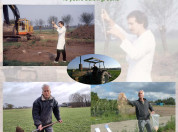Search
Filter by
Type
Tags
Dossiers
Themes
Departments
Active filters
16 search results
Search results
-
From Pioneer to Soil Prophet: 40 years belowground - Farewell symposium Wietse de Boer
On Thursday April 4 we'll have the Farewell Symposium and reception for our long-time colleague Prof. Dr Wietse de Boer (Department of Microbial Ecology at NIOO and Wageningen University).
-
How genetic research contributes to effective lion conservation
Human measures to protect lions have an impact on the genetic health of populations. Dutch and Kenyan scientists discovered this by analysing the DNA of 171 Kenyan lions. "By fencing reserves, for example, the chance of inbreeding increases." With the knowledge and tools from the research, management authorities in Kenya can better protect their valuable wildlife in the future.

-
Biodiversity on the NIOO terrain
At NIOO we strive to stimulate the biodiversity on the green roofs and the terrain. On the occasion of NIOO’s 68th birthday, colleagues launched a BioBlitz: a period of biological surveying to record the living species within a designated area.
-
BiodiversityXL Community Event at NIOO
The next BiodiversityXL Community Event is coming up soon and this time it's going to be at NIOO!
-
Biodiversity XL Live: The Sound of Biodiversity
Yet another fascinating episode is coming up for the BiodiversityXL Live short livestream series: the Sound of Biodiversity! More and more different approaches and techniques are used, in the hope to gain more knowledge about biodiversity. They help us to look very detailed at individuals, species and ecosystems. But let's not forget about our ears. Sound can tell a lot about the presence of species, but also about their behaviour. Sounds we can hear, like bird songs, but also sounds we can not hear. How do we monitor biodiversity via sound?
-
PhD thesis defence Eline Ampt-Blom: plant-fungal interactions effects on disease risk belowground
Eline Ampt-Blom will defend her PhD thesis "Deciphering belowground plant-fungal interactions to understand the effects of biodiversity on disease risk"
-
NIOO Theme Sustainable use of land and water
Healthy surface water and soils are essential for life on earth. They provide a range of life-supporting functions, including carbon storage, oxygen generation, and nutrient cycling. At NIOO, we combine research on the ecosystem services provided to society with research on how these ecosystem services are impacted by society.
-
Multifunctional grounds
Besides the latest ecotechnology, the grounds also feature aviaries, ponds, greenhouses and experimental gardens.
-
Bringing nature into the city
We aim for maximum biodiversity on and around our building. But what can we do to increase it?
-
A living, breathing building
As sustainable as possible, in as many respects as possible: that was the imperative when the Netherlands Institute of Ecology (NIOO-KNAW) commissioned a new building. And we have done it!
